I spent New Year’s weekend with dear friends in Ottawa. For the first time ever, I left my vacation rental, the upper floor of my house, in the hands of complete strangers.
What could go wrong? (She asked with trepidation.)
In fact, some things did go wrong but not nearly as wrong as they could have. There was no significant damage, a few small items went missing, and the cleaning of the unit wasn’t up to a “rentable” standard. Renters are asked to return the unit to the state in which they found it. A few rules were broken (i.e. no fireworks) and they left behind a HUGE amount of garbage. At least most of it was in bags.
After a few emails back and forth, I settled on returning only half their deposit money and using the balance to hire my local and reliable cleaners to put the place to rights. This is, in fact, the purpose of the deposit system.
Here are some takeaways I’ve arrived at from this episode.
a) Emotional response: I just couldn’t confront the relatively minor mess inside, and the bigger mess on the deck. I felt affronted that people wouldn’t read the departure checklist and take an hour to do some simple things like strip the beds and run the vacuum around. I managed to get the deck in shape myself, after animals had investigated the three bags of food garbage left out there. But without help, I simply wouldn’t have gotten to the inside clean-up. It wasn’t a time thing or an “I’m too good to clean” thing. I was offended.
Some of my renters, the ones who are crossing over into friend turf now, asked me over beverages at the firepit last summer if I felt “invaded” by people in my space. I really don’t. It actually pleases me to hear laughter and conversation upstairs, and to see people at the waterfront enjoying themselves. The vast majority of people have been pleasant, respectful and really great to have around. The rental unit itself no longer feels like “my space”.
But, clearly, I feel like I’ve been kicked when I inspect afterwards and find myself underwhelmed with the care taken of the space after I’ve carefully prepared it for the comfort and ease of the guests.
b) It wouldn’t have mattered if I was home. The only thing I might have been able to catch if I were home would have been the fireworks going off. Unless I’m specifically asked, I don’t inspect the place with the renters standing there. On one or two occasions, some groups have asked me to complete the inspection so they could be assured that they would be getting their deposit back. Fair enough. But if I’d been home, I don’t think the outcome of this rental episode would have been materially different.
c) Don’t go there. My reliable cleaners, bless them, are good people who have not much experience beyond the local area. They asked me after cleaning if the renters had been “foreign”. Not thinking, I said yes, and named the country of origin of this rental group. This caused one of the cleaners to launch into a monologue about people from elsewhere.
The speed with which this exchange went from friendly chat to political diatribe was mind-boggling and I stupidly didn’t see it coming. At least I was quick enough to nip the monologue in the bud to point out that the origin of the rental group was not the problem. Maturity, adherence to rules, possibly lack of on-site supervision (they could get away with it), and just plain ol’ “did your mother let you leave your room like that?” … and don’t tell me that there are not home-grown Canadian travellers who have trashed hotel rooms, pensions, and bed/breakfast rooms. Bollocks.
This is the stuff we’ve got to nip in the bud – the finger-pointing and blaming anything we don’t like about a person’s behaviour on that person’s “otherness”. This always defies logic. Hearing it and confronting it is more important now than ever before. Please, if you are reading this, join me in not letting this stuff fester in our conversations because this is how such monochromatic beliefs are formed and reinforced.
Don’t let them get away with it.
The Dachau Concentration Camp Memorial site is set up to educate with as much clarity and sensitivity as possible while also 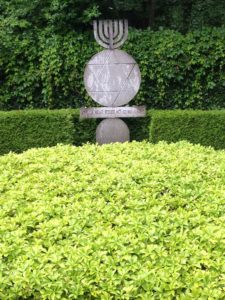 memorializing the tragic brutality that this ground witnessed. There are multiple sculptures, plaques, monuments, etc. that commemorate the victims and the crimes perpetrated. Newer buildings are on site as memorials, sponsored by multiple faiths that had clergy/leaders/members in the camp, including obviously a Jewish representation but also Catholic, Protestant, and Russian Orthodox. One of the buildings is currently in use as a nunnery.
memorializing the tragic brutality that this ground witnessed. There are multiple sculptures, plaques, monuments, etc. that commemorate the victims and the crimes perpetrated. Newer buildings are on site as memorials, sponsored by multiple faiths that had clergy/leaders/members in the camp, including obviously a Jewish representation but also Catholic, Protestant, and Russian Orthodox. One of the buildings is currently in use as a nunnery.
There is no minimizing, dodging or obfuscating the role of this camp, the first concentration camp, in setting the tone for other camps. Everything that was done elsewhere started here. Given all the things I saw as testament to the crimes and death that occurred … what is really a struggle for me is understanding how vast the network of camps and sub-camps was. We were shown a map of the territories held by Germany at the peak of the war and the map was filled with literally hundreds of locations where versions of this place, in smaller and larger scales, were located. We have heard only of a handful of the usual names – Auschwitz-Birchenau, Treblinka, Bergen-Belsen, Dachau. But there were literally hundreds of camps and sub-camps. I was aghast at the breadth and scope of barbarism undertaken across such a wide geographic area.
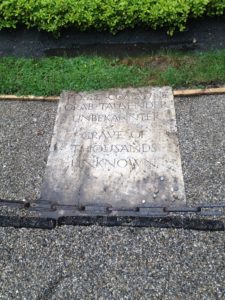
Grave to mark ashes of thousands of unknowns (Jewish Memorial)
During my visit, it was (mostly) quiet. People were respectful and clearly there to learn, to try to comprehend, to absorb. Entrance to the site is free. I’d estimate there were a few thousand people there while I was there, so it is well used. There are lots of trees around the exterior of the camp proper, and thus lots of birds singing. That seemed out of place, as if the birds should know better. It poured rain, on and off, and that seemed entirely in keeping with the mood. Our tour group had 15 high school kids from Indiana and it was interesting to watch them go from being “too cool for this” and sort of detached to being really quite sober. I overheard discussion of the use of this memorial site for school groups and it appears that schools from all over Europe and North America make stops here. That feels like a good thing, but it does make it a bit of a challenge for maintaining the appropriate decorum when pre-teens and teens are responding to what they see with humour or (feigned) apathy. I think Dachau has an impact on everyone who visits and I think it is important for as many young people from as many different backgrounds as possible to see it – and I also think that kids don’t always know what to do with their emotional responses “in the moment”.
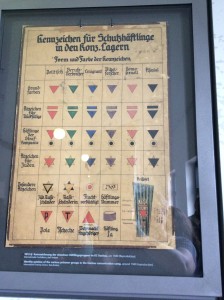
The Original Pink Triangle
It felt oddly synchronous to be looking at the actual original pink triangle symbol, as deployed to identify a homosexual “enemy of the state”, the day after World Pride had wrapped up in my home city of Toronto. There is no more clear reason to justify the existence of an event like “World Pride” than standing in an original building at Dachau and looking an original wall chart of symbols used to identify people, one of which was a pink triangle. Interestingly, there is a committee of survivors that has a crucial role in determining the types of memorials that will be allowed. A memorial focusing on homosexuals is absent because, in the hierarchy / social structure of the camp at the time, homosexuals were at the bottom of the barrel along with known criminals and other “asocials”. The committee of survivors isn’t comfortable acknowledging the targeting of homosexuals by approving a memorial for this group. When I spoke to our guide about this privately, he suggested that people were waiting for the committee of survivors (which is quite small now) to hand over their legacy to perhaps a more current committee with a more current perspective. I would have liked to have seen something there as an acknowledgement that gay people were one of the many groups identified as “enemies of the state” – and I also think this can wait until the time is right. Homosexuals are identified within the part of the exhibit that describes all the targeted groups, and our situation is given as much detail and focus as most of the other groups.
I took only a handful of pictures. It didn’t seem … seemly.
Dachau is just outside of Munich and the typical journey one takes to get there is from the Hauptbahnhof (main train station) in Munich. It is a short 10-15 minute ride. German citizens in Munich are extremely sensitive about people coming to visit to learn more about Nazis and about concentration camps. I knew about specific laws around giving an Nazi salute (even in jest, this will get you arrested) and I didn’t realize Mein Kampf was still a banned book. It was odd to be taking a tour with a group to specific sites relevant to WWII and to be scrutinized by the locals. They will listen and try to be sure the guide isn’t Munich-bashing or sensationalizing. Locals are also concerned with Neo-Nazis using specific sites as touchstones for their own purposes. As much as they don’t want their quite beautiful city associated with the rise of the Nazi party, as it happens, this is now a key part of the city’s past. Never mind that the PLO leveraged this association with the murders during the Olympics in 72, which adds another horrific piece to the global perception of Munich. I don’t want to suggest that Munich has had a bad rap – it is what it is – but it is a pleasant place, rich in layers of history beyond the 20th Century, walkable, reasonably friendly – I quite enjoyed it.
There are lots of very subtle, slightly subversive, commemorative elements in Munich. Many bullet holes and other types of damage have
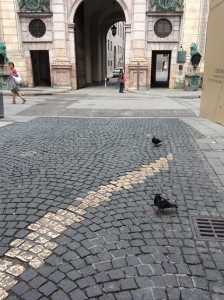
Dodger’s Alley
been left, on purpose, unrepaired, in the architecture, like reminders. Scars. You have to look for these, but they are there. A more deliberate, striking example is a metallic (gold? bronze?) shimmering trail down the cobblestones in an alleyway known as Dodger’s Alley. In the 30’s/40’s, citizens of Munich who walked by a specific Nazi plaque on the corner of one of the main squares had to give a Nazi salute or be arrested for not doing so. There were lots of people who didn’t want to give a Nazi salute. So, to avoid walking by that plaque, many would take a detour down Dodger’s Alley. Nazi authorities caught on to this and started policing the use of the alley, interrogating people found in the alley as to their purpose for being there. If no satisfactory purpose was offered, a person would be thrown immediately into Dachau. Just for taking a detour to avoid giving a salute. Even these people were “enemies of the state”. As to the metallic trail, there is no plaque or explanation. You need to just know, or be told, why it is there and what it signifies. Apparently, there are lots of these sorts of things all over the city, commemorations of resistance. I didn’t have time to go find more, unfortunately.
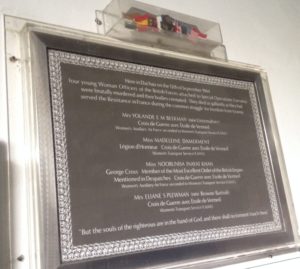
Four Heros You Need to Know About
I will close by noting this plaque. It is almost hidden behind a door that leads from the gas chamber into the crematorium. (Please don’t imagine that I typed that sentence with any degree of casualness.) There is a railing in place, making it harder to get a straight on, close photo. Since it is hard to read, I’ll type out what it says here. They gave their lives – the least I can do is try to get this right.
Here in Dachau on the 12th of September 1944
four young Woman Officers of the British Forces attached to Special Operations Executive
were brutally murdered and their bodies cremated. They died as gallantly as they had
served the Resistance in France during the common struggle for freedom from tyranny.
Mrs. YOLANDE E M BEEKMAN (nee Unternahrer)
Croix de Guerre avec etoile de Vermeil
Women’s Auxiliary Air Force seconded to Women’s Transport Service (F.A.N.Y.)
Miss MADELEINE DAMERMENT
Legion d’Honneur Croix de Guerre avec etoile de Vermeil
Women’s Transport Service (F.A.N.Y.)
Miss NOORUNISA INAYAT KHAN
George Cross Member of the Most Excellent Order of the British Empire
Mentioned in Dispatches Croix de Guerre avec etoile de Vermeil
Women’s Auxiliary Air Force seconded to Women’s Transport Service (F.A.N.Y.)
Mrs ELIANE S PLEWMAN (nee Browne-Bartoli)
Croix de Guerre avec etoile de Vermeil
Women’s Transport Service (F.A.N.Y.)
“But the souls of the righteous are in the hand of God, and there shall be no torment touch them”
Bravery, compassion and a complete and utter focus on their missions, to the exclusion of all else, including their own lives. This was a surprise find towards the end of my visit to Dachau – but it shouldn’t have been. I feel like I should know these names and that I should know more about these stories. Their world, a world in which their skills and dedication were needed at extreme cost, is not that far removed from our current time of social media, popular culture, ridiculous fads and trivial pursuits.
Do not forget.
If you are a history nerd/buff and are visiting Munich, you must look up Taff Simon/Dark History Tours. I know of no other tour guide who carries centuries worth of props, artifacts, costumes and even a sword around with him to augment his story-telling. (What a work out that must be!)
I had some plans change at the last minute and found Taff by googling something like “what to do in Munich”. We had an email exchange and he wound up adding me to the end of his long day of group tours for a quick walk around downtown in the early evening. This was above and beyond, in my opinion, and I learned more in that short few hours than ever expected to. I peppered him with questions on such a wide range of historical eras – from ancient tribes in the area to WWII – and he fielded them all. Taff is a trained and experienced archaeologist and historian with a clear passion for all things historical.
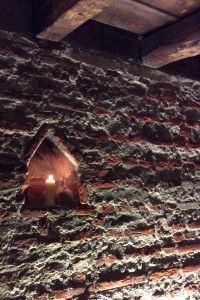
They don’t make them like this anymore.
We stopped for a beer – everyone drinks beer in Munich – in the oldest pub in the city. These bricks were hand formed over 600 years ago – some of the finger impressions in the bricks are still visible.
I learned more new facts about the rise of National Socialism in Munich, including the early location of the Gestapo headquarters and the dining hall where Kristallnacht was likely planned and set in motion by all the leading Nazi figures of the time. Other tours take some of the standard approaches, and these are key too – the Beer Hall Putsch, the locations of early Nazi rallies, the struggle of today’s citizens of Munich to acknowledge their city’s dark role in the establishment of the roots of Nazism. Taff adds extra detail to flesh out these elements and make them come alive.
In one of the courtyards towards the end of our tour, he demonstrated what a medieval man of status would look like, pulling out costume items and accessories, all the while discussing the whys and wherefores of each item. The courtyard we were in has historical significance through many periods of time, including being used as a marketplace where men in his style of dress would have been present. It was engaging, fascinating and fun.
Taff is obviously a walking 3D History Channel and it is worth a detour to Munich, if you hadn’t planned to be there, just to hang out with him. If you are planning some time in Munich, you must look up Taff Simon and Dark History Tours. You will not regret it.
The hair on the back of my neck stood up on the bus ride up Kehlstein to Eagle’s Nest. There were perhaps three reasons for this.
1. The views … who needs to rent a helicopter to line up aerial shots?!? A lazy cinematographer would only have to take this journey to get a clear sense of what is possible. Â I am convinced that the lake in the distance, Lake Konigsee, is the one seen in the opening shots of the Sound of Music when the helicopter comes over the crest of a mountain and looks down on a lake with a boat motoring along, wake lazily spreading out behind. Look in the Ducky shot, off in the distance.
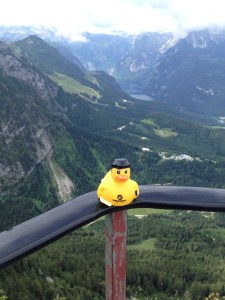
Steady … steady …
2. The place … Hitler’s supposed summer retreat. This would creep any thinking person out.
3. The ride … which compares with almost anything Canada’s Wonderland has to offer. Hairpin turns, lightning speeds, narrow tiny one lane road with no means of accident avoidance, narrow tunnels taken at speed.
To get here, one takes a tour bus from downtown Salzburg to an unnamed spot which I later learn is / was called Berchtesgaden/OberSalzburg. It is actually in Germany, just over the border. More on this later. From this big parking lot/tour bus depot/ticket office/souvenir shop, one boards a specially designed bus, one of six, with upgraded engines and brakes. This is what gets you to Hitler’s parking lot, from which spot one takes the original elevator (not a Schindler, I asked) directly up into the Eagle’s Nest building.
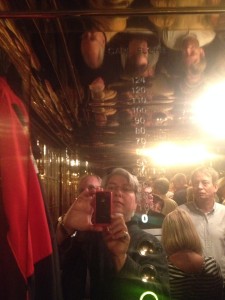
Photo of interior of original elevator, in reflection, showing manufacturer Carl Flohr.
We are told on the journey up, by the tour guide, that Hitler hardly ever came to Eagle’s Nest because, ironically, he was afraid of heights. Chickenshit. An Internet factoid, of dubious credibility, suggests that he only visited the place 14 times. Construction was completed in 1938. There are, therefore, seven summers possible that he could have visited, so twice per summer. There is some raw footage on Youtube of Eagle’s Nest in use which I watched after. This is what makes my hair stand on end, still. The footage shows the exact place, practically unchanged, that I just visited. The filmmaker made a vista shot, circa 1939, exactly the same as one I took earlier in the day. It looks, for all the world, like B-roll from the opening credits of the Sound of Music that might have wound up on the cutting room floor.
I typed my initial thoughts on this entry into my iPhone while at the top of Kehlstein. IÂ like that autocorrect consistently likes to change Hitler to either “girl” or “butler”.
One of my burning questions had to do with who was profiting from this rather popular tourist activity. Â It turns out that profits from the gift shop, restaurant and bus tours to Eagle’s Nest go to support local schools and charities. No single individual profits from this activity and no single organization is touted. I’m not sure the restaurant even has a name. There is no branding of any kind. The restaurant is marked “Restaurant” and the gift shop is called “Shop”.
I had steadied myself for the creepiness of visiting the heart of nationalism, or of anti-internationalism, if you will. Having Ducky along as a photo buddy helped take some of the creep out. Still, riding in Hilter’s elevator and standing by his fireplace is chilling. Â Which brings me to Berchtesgaden/OberSalzberg. It wasn’t until I was reading the materials on the bus on the way back that I realized that the actual summer compound where much time was spent by Hitler, Goring and others was OberSalzburg. The architect confiscated land from local farmers, without compensation, and built a real summer retreat here – right where the buses now jockey for position to transfer tourists from the weak-ass tour buses to the souped up tour buses. The guide didn’t tell us this. On the land was a village of summer homes for Nazi officials, useful facilities, and gathering places. Below ground, there is a complex series of bunkers, facilities and shelters. Allied bombers did some damage to the above ground complex in 1945 as the “American Zone” expanded. The locals blew up all the remaining buildings in 1952 and wrote a local bylaw restricting anyone from owning land or building residential buildings on the site, in perpetuity. With one exception – a small hotel/restaurant was returned to the family from which it was taken by the Nazis when they built the site. It still operates as a hotel/restaurant and is the only remaining entrance to the network of tunnels below surface. We may have driven by it and I wish I’d known to look for it.
Update: So, my Eagle’s Nest visit was yesterday and I had been using my GPS to note the relative location of the “Sound of Music” hill that I had a half-baked plan to visit. “The hill” is hidden behind some farmers’ houses in the middle of almost nowhere on the border of Austria and Germany, on the German side. As we went to/from the Eagle’s Nest, my GPS suggested it was very close, just over one of the mountain peaks perhaps. Turns out it is even closer. 12 km. The Sound of Music “hill” is closer to Hitler’s summer retreat than it is to Nonnberg Abbey, which is 20 km away.
There is lots to love about Germanic efficiency. For example, the city bus stops have the bus routes numbered and colour-coded. The main bus stops have electronic signs that tell you how many minutes you will wait for your bus. You can count down the minutes and, like clockwork, the bus appears during “0” minute. Very nice.
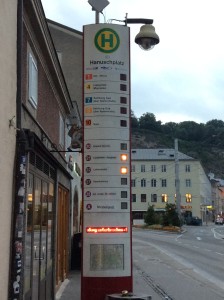
… but when it stops, nobody knows.
I know about 20 words in German – enough to get around without offending people. And everyone seems to have at least 100 words, often much more, in English so it is all good. Â I can’t do anything more complex than the pleasantries.
Enter the mildly complex problem of trying to ascertain the arrival of a bus that has no electronic number to indicate its arrival time. Blank screen. It was around 9 p.m. Had the buses stopped running? That didn’t make sense – it wasn’t that late and there were still lots of people around. I thought I’d ask when I bought my ticket. I went into a souvenir/corner shop. The proprietor is of Asian descent:
Prop: (something in German, probably can I help you?)
Me: (smiling) Yes – I’d like to buy a ticket for the bus.
Prop: (smiling) Oh, I don’t sell those. You need to go to cigarette man (pointing).
Me: Ah, ok. Do you know if the buses are still running now?
Prop: (puzzled, stlil smiling) Yes, the buses run right past here. Stop there. (Pointing)
Me: Yes, I know the bus stop. But are they still running now, at night?
Prop: (insistant) Yes, the buses run right past here. Stop there. (Pointing)
Me. OK.Thank you.
Alright, maybe cigarette man will know. No buses had gone by in the last five minutes so I was starting to get concerned. Dodging city buses is a newly acquired Salzburg skill of mine.
Me: Hi – I’d like to buy a ticket for the bus.
CM: (nods)
Me: By the way, have the buses stopped running tonight?
CM: The bus stop is here. (Pointing)
Me: Yes. But are there any more buses stopping here tonight?
CM: (staring at me like I’m an idiot American which is categorically incorrect. I’m a dumbass Canadian.) The bus stop is here. (Pointing)
OK … I’ll just wait here for a while. 🙂 I’ve got lots of time. I’m on vacation.
Magically, the bus appeared within minutes, even though the sign refused to predict this. See what happens when you set my expectations high around efficiency? I now expect consistency!
8. Soundscape: Unbelievable. Â The glorious cacophony of all these towering bells and glockenspiels, all trying to state the time simultaneously. Dozens, hundreds of languages. Clip clop of horses gently towing the tourist buggies carriages around. Â Lots of birds singing, especially around Nonnberg and Miribell Gardens.
9. Don’t Miss It (3): The composer of  my favourite Christmas carol was born in Salzburg.
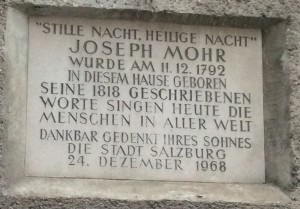
Silent Night Composer – Joseph Mohr
10. When is a throne room really a throne room? The Austrians seem to have struggled with the concept of the separation of Church and State. The term “Prince Archbishop” seems to have been thrown around a lot prior to the Napoleonic wars. The creative forces behind the movie Amadeus must have taken character design from the paintings in Festung HohenSalzburg (the big castle) and in the Salzburg Museum. Speaking of that movie, think of Mozart’s father pleading with the Prince Archbishop for his son to be forgiven for some misdemeanour or other. The Prince Archbishop was second only to Emperor Joseph. In any case, the state rooms, at the very very tippy top of the castle overlooking Salzburg, have been left in more or less their orignal condition, mostly wood, ornate and rich designs. But … who wants to go all the way to another floor to do one’s unofficial business? Here is a throne room inside a throne room!!
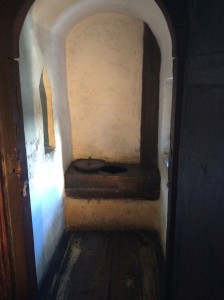
Throne Room
1. Free WIFI: Festung Hohen Salzburg (Salzburg Castle) has free WIFI. Cool!
2. The destitute: There are more panhandlers per square km here than I have ever seen in Toronto or anywhere else.
3. Universität Salzburg has 12,000 students who have to fight through the Sound of Music / Mozart / Music / Photography buffs who roam these tiny streets daily. Most of the students seem to be earnest, serious, clean-shaven young white men riding bicycles. They congregate on street corners in the inner parts of the city, smoking and arguing with each other in emphatic German. The presence of a strong student population makes it possible for the Mozart, Haydn and R. Strauss themes to be juxtaposed with places like Jango, the world music cafe and the Afro Africa Cafe. Aside from this, you’d have to look hard to find a radical counterculture here.
4. Was ist diese Anschluss von dem Sie sprechen? I always thought “anschluss” meant “annexation”. Then I rode around on the Salzburg city buses a while. The automated voice repeatedly says “anschluss”, as it relates to specific stop. “Next Halt – Griesgasse … anschluss, Haupbanhof.” It means “connection”. I couldn’t figure out how bus stops were related to annexation. *facepalm* If Captain Von Trapp were riding the bus, Herr Zeller could say, “If the anschluss is coming, and it is coming Captain … perhaps you’d find your way back to Hotel Bristol if we set the bus connections to music!”
5. Don’t Miss It (1): If you spend too much time staring at the horse fountain in Residenzplatz, you’ll miss the commemoration of the Nazi book-burning in 1938.
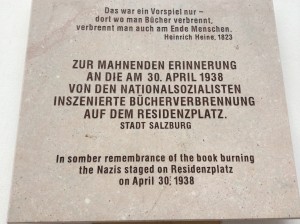
6. #1 Leading Cause of Concussions in Salzburg: If you are 5′ 8.5″ tall, and are agog at the interior of St. Peter’s Cathedral, so much so that you stop RIGHT IN FRONT of the door you just came through so you can take a picture … you might get a concussion from the next person coming through the door. There is a sign about this in tiny letters on the door. Â See the tiny blue plaque?
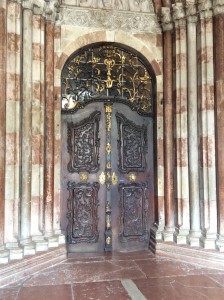
See the tiny blue sign?
Now, imagine going through this door with no expectation of seeing this …
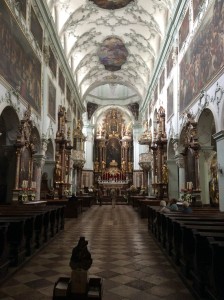
First Glimpse – the Wow Effect
Some football hooligan dude came through the aforementioned door at full speed while I was trying to set up this photo. Ow. He apologized in German or some similar language.
But then there was this, so it is ok.
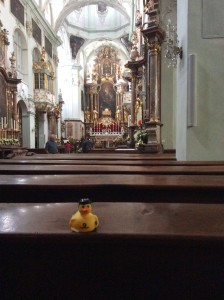
Ducky takes a moment
7. Don’t Miss It (2): If you spend too much time reveling in the magnificence of St. Peter’s section of the city, you may miss that part of it served as the headquarters for the Gestapo in WWII.
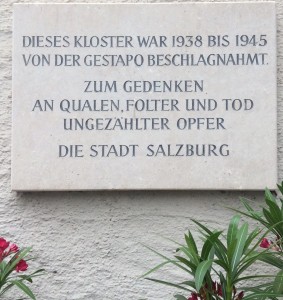
Confiscated by Gestapo
The translation, loosely, is something like: This cloister was confiscated by the Gestapo from 1938 to 1945. Â In memory of torment, torture and death of (untold?) victims. The City of Salzburg.
Continued in next post …
I decided to take my kayaking buddy, Ducky, on this trip to Europe. Â She seems to be enjoying herself.

Upon arriving, taking a moment to get organized.
 memorializing the tragic brutality that this ground witnessed. There are multiple sculptures, plaques, monuments, etc. that commemorate the victims and the crimes perpetrated. Newer buildings are on site as memorials, sponsored by multiple faiths that had clergy/leaders/members in the camp, including obviously a Jewish representation but also Catholic, Protestant, and Russian Orthodox. One of the buildings is currently in use as a nunnery.
memorializing the tragic brutality that this ground witnessed. There are multiple sculptures, plaques, monuments, etc. that commemorate the victims and the crimes perpetrated. Newer buildings are on site as memorials, sponsored by multiple faiths that had clergy/leaders/members in the camp, including obviously a Jewish representation but also Catholic, Protestant, and Russian Orthodox. One of the buildings is currently in use as a nunnery.














